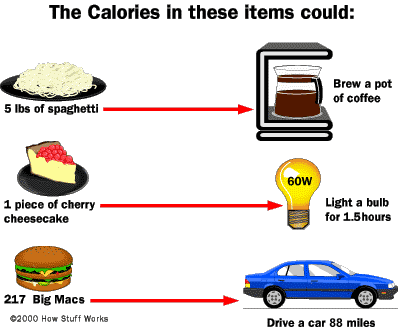
Calories in calories out: myth or fact?
There has been a lot of debate on the calories in, calories out formula lately, and how it impacts weight. Essentially, whether the total amount of calories consumed has to be less than the total calories burnt, for fat loss. Many people in the health community claim that this model for fat loss is not correct or just too simplistic and not all calories are the same. Other health gurus claim that, yes, it is that simple. Well the former is right…and wrong…and so is the latter. It depends on how you look at it and how things are defined. Confused much?… Well let me explain. First we need to agree on a common ground before we can discuss which is correct. That common ground will be the definition of a calorie.
What is a calorie? I am going to keep this as simple as possible. A calorie (small calorie: cal) is a unit of energy. It is the energy required to raise the temperature of 1 gram of water by 1 °C. A  large calorie (Cal), which is the one used in connection to food, is defined in terms of kilograms and is equivalent 1000 small calories or 1 kilocalorie [1]. The take away here, is that a calorie is a unit measure of energy. When we talk about calories in food the definition is the same. Therefore all food calories are the same, whether it comes from carbs, fats, sugars, proteins. It does not matter, the foods may provide different amounts of calories, but the definition of a calorie (Cal) does not change. I don’t know how accurate the image is on the right, but the point is, that calories are just unit measures of energy.
large calorie (Cal), which is the one used in connection to food, is defined in terms of kilograms and is equivalent 1000 small calories or 1 kilocalorie [1]. The take away here, is that a calorie is a unit measure of energy. When we talk about calories in food the definition is the same. Therefore all food calories are the same, whether it comes from carbs, fats, sugars, proteins. It does not matter, the foods may provide different amounts of calories, but the definition of a calorie (Cal) does not change. I don’t know how accurate the image is on the right, but the point is, that calories are just unit measures of energy.
Protein calories are better than carbs and sugar calories for fat loss…right? If you believe that, then you didn’t understand the previous paragraph. Read it again and then come back here…I’ll wait…hmmmmmm…okay ready? All calories are the same…all foods however, are not created equal. Whole foods, proteins and fats take longer to digest than simple carbs and sugars. They also require more energy to be processed by the body, thereby using more calories. So what does this really mean? Say you have a steak and a sugary high carb pastry, with the equivalent amount of calories in both. The pastry is processed faster and requires less energy, whilst the steak uses more energy or calories to process. So the net calories gained from the steak is less than that gained from the pastry. So, it’s not the calories that are different, it’s the food and how it is broken down and used by the body. So the added energy costs from digesting protein can be of benefit, if trying to lose weight [1, 2] since it is greater than with fats, carbs and sugar. At the end of the day, it is still the calories in calories out model that counts. You necessarily have to expend more calories than you consume to lose fat…one way or the other. Having said that, it is still important to look at where your calories are coming from.
how it is broken down and used by the body. So the added energy costs from digesting protein can be of benefit, if trying to lose weight [1, 2] since it is greater than with fats, carbs and sugar. At the end of the day, it is still the calories in calories out model that counts. You necessarily have to expend more calories than you consume to lose fat…one way or the other. Having said that, it is still important to look at where your calories are coming from.
Food (low calorie…I promise) for thought When you hear of, or read about the calorie in, calorie out model being wrong, and that fat loss is not that simple, you now know better. Fat loss may not be simple, but at the end of the day you need to expend more calories than you consume to lose the fat. What about exercise? Well you do burn calories during exercise, but not as much as you think. You can burn a couple hundred calories running on a treadmill for an hour. Or, if you do some sort of HIIT exercise like Orangetheory fitness, from 500 to 1000 calories with an after burn of about 14 0 Cals. This does contribute to you caloric expenditure and can help with fat loss. But, the truth is that most of the battle against obesity is won or lost in the kitchen, or cafe, or lunch room… Exercise helps with fat loss (also has other benefits), but focus on what you eat. You can aerobicize, do HIIT, run on a treadmill, do cardio kickboxing all you want. If you pick up that Twinkie, hunk of cheesecake, chocolate bar or pastry that you like, you’ve just wasted your time in the gym as far as fat loss goes. That one slice probably has as much calories as the amount you burnt during your workout. I’m not saying don’t have the occasional sweet treat or have a cheat day, just don’t make it a habit. A workout is not license to eat whatever you want, whenever you want. Having said that, you might be wondering, “if I burn calories digesting food…then…Eureka! I can eat foods that are low in calories, like broccoli or celery, and during digestion I will burn more than I took in.” Not so fast, the negative calorie food is a myth. There is zero science to back this foolishness up. Despite what many health and fitness people say, don’t buy into it.
0 Cals. This does contribute to you caloric expenditure and can help with fat loss. But, the truth is that most of the battle against obesity is won or lost in the kitchen, or cafe, or lunch room… Exercise helps with fat loss (also has other benefits), but focus on what you eat. You can aerobicize, do HIIT, run on a treadmill, do cardio kickboxing all you want. If you pick up that Twinkie, hunk of cheesecake, chocolate bar or pastry that you like, you’ve just wasted your time in the gym as far as fat loss goes. That one slice probably has as much calories as the amount you burnt during your workout. I’m not saying don’t have the occasional sweet treat or have a cheat day, just don’t make it a habit. A workout is not license to eat whatever you want, whenever you want. Having said that, you might be wondering, “if I burn calories digesting food…then…Eureka! I can eat foods that are low in calories, like broccoli or celery, and during digestion I will burn more than I took in.” Not so fast, the negative calorie food is a myth. There is zero science to back this foolishness up. Despite what many health and fitness people say, don’t buy into it.
Summary Calories are a unit measure of energy and the definition is the same no matter what the food source is. Calories in, calories out is essentially correct. You do need to expend more than you consume to lose fat. All foods are not created equal and choosing to eat less refined carbs and sugars goes a long way in helping with fat loss. For good overall health, a combination of diet and exercise is needed. There are other benefits to choosing to reduce carbs and sugars from diet beside fat loss. Doing so, reduces inflammation which helps to alleviate a host of problems, including heart attacks when combined with cholesterol. You can read about it here. Now you know how calories work. Keep checking back for more informative posts on fat loss and health. Remember to like on facebook.
P.S. The Healthy Goat was last seen trying to eat a jelly donut and run on a treadmill at the same time. He wanted to make sure he expended more calories than he consumed. Alas, he lost his balance and went flying backwards into the wall…jelly donut and all. The Embarrassed Goat was escorted out of the gym by management, but not before he was made to clean off the jelly donut from the treadmill…wall and all.
